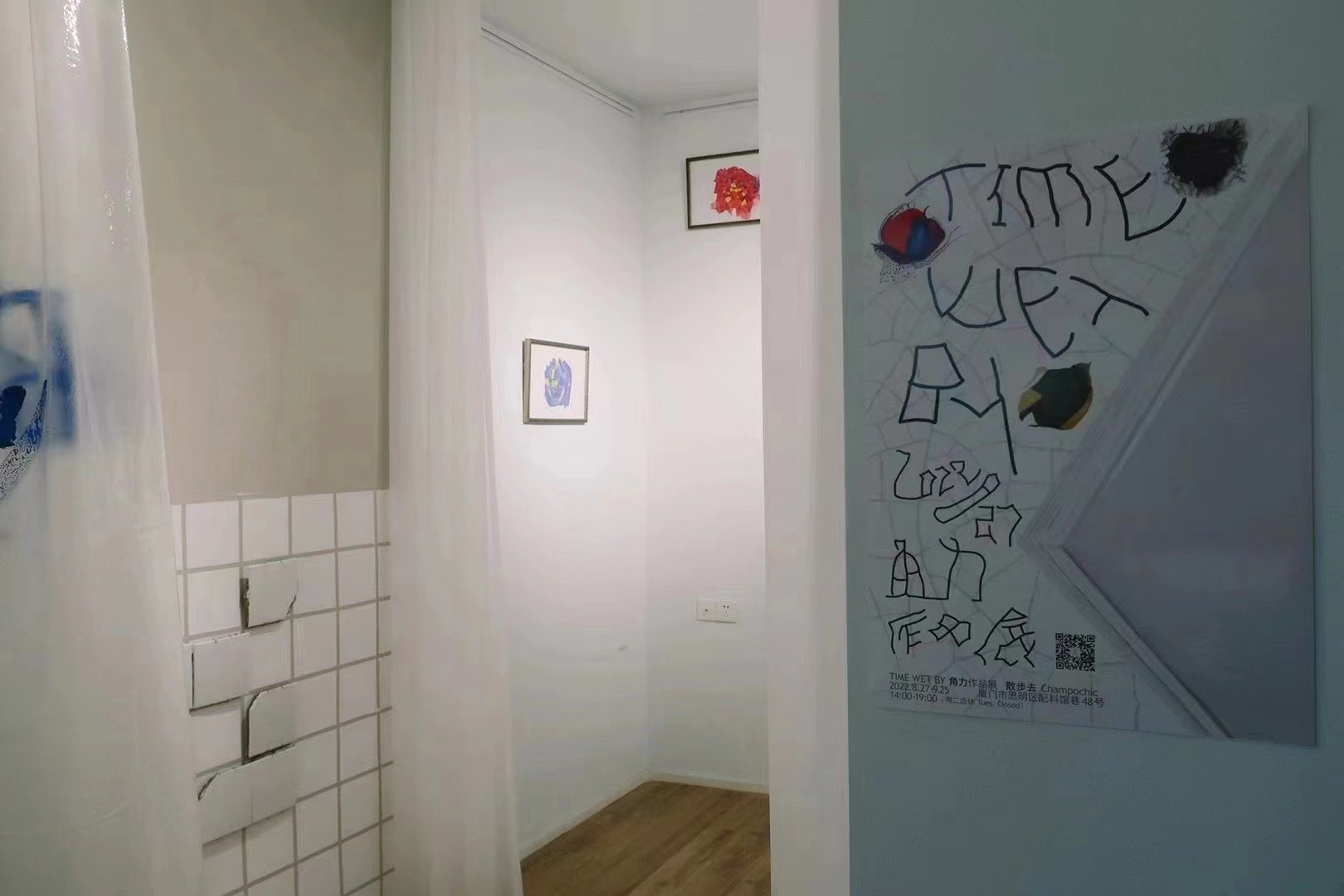


展言:
也许很难以想象,艺术家公寓浴室墙壁上的一些旧瓷砖会成为一个有趣艺术项目的开端,然而驻地北京的艺术家角力,真的为我们带来了这种充满好奇的视角。在本次的《Time Wet By》角力作品展中,她将把我们的视线带到了我们不曾留意的日常物品与现象上。
陶瓷材料上会出现“开片”的现象主要是由于釉料和粘土体本身存在不同的膨胀系数,从而产生了不同程度的开裂。然而,这些偶然的制作“缺陷”仍然普遍存在于当今的陶瓷生产中。另一方面,其实“开片”的观察和记载,一直存在于中国历史的过往。宋代五大名窑之中的哥窑,其陶瓷作品的开片就尤其受到赞誉,并且仍强烈影响着现代陶瓷艺术的美学。
从观察浴室瓷砖上的裂纹作为一个开端,角力采取行动,取下墙面上的瓷砖,透过描绘裂纹的轮廓从而介入创作,然后选择以水彩绘画的方式进一步扩大自己与这些瓷砖的互动。
这是一个有趣的过程。我们(人类)先从自然界中获取材料,运用了人类驱动的工业过程创造了“瓷砖”。而在自然状态下,“时间”和“空间”在瓷砖上留下了自己的印记,形成了我们人类无法控制的新一轮干预。随后,人类艺术家出现,观察这种变化,并在这个现象上,将自己介入,创造了一组“新”的绘画作品。
然而,我觉得艺术的最终结果并非是“制作精美的画作”。 在这次特定的努力中,角力想呈现的,更多是一个艺术的“过程”,而不是一张张的绘画结果。因此,她似乎有必要找到一种合适的艺术输出,来更好地强调自己所尝试的这一个过程。这次的艺术计划中,她还采用了有着一片瓷砖作为封面的“艺术概念书”作为她的工具/作品形式,从而传达她所经历的艺术之旅。
她将展览空间重新塑造成浴室,带来了真实的瓷砖、裂纹的轮廓、水彩画作,以及,在笔者看来在这之中最重要的艺术概念书《Time Wet By》。有趣的是,现场的瓷砖将完全对应2000公里外角力浴室里的“原位”。而每件水彩作品的名称也是根据空间直角坐标命名的,再次重申了它们与瓷片之间的联系。
自然状态—人为干预—自然状态—人为干预,展览呈现了这样的一个过程。角力把自己对日常事物的探索,展现在我们的眼前。这些瓷砖在时空中穿梭,仿佛是在经历一场属于自己的冒险,是艺术家有意发起的,有时甚至可能只是部分参与。
我们可以将《Time Wet By》的艺术概念书看作为一个“终结”,角力的一个艺术历程的总结性记录。但同时,它是否能是一个“新的开始”,促使着我们去关注日常生活中那些无人看管的物品,去思考这些物品在无尽的时间和空间中所产生的记忆、可能性、冒险和命运。
也许很难以想象,艺术家公寓浴室墙壁上的一些旧瓷砖会成为一个有趣艺术项目的开端,然而驻地北京的艺术家角力,真的为我们带来了这种充满好奇的视角。在本次的《Time Wet By》角力作品展中,她将把我们的视线带到了我们不曾留意的日常物品与现象上。
陶瓷材料上会出现“开片”的现象主要是由于釉料和粘土体本身存在不同的膨胀系数,从而产生了不同程度的开裂。然而,这些偶然的制作“缺陷”仍然普遍存在于当今的陶瓷生产中。另一方面,其实“开片”的观察和记载,一直存在于中国历史的过往。宋代五大名窑之中的哥窑,其陶瓷作品的开片就尤其受到赞誉,并且仍强烈影响着现代陶瓷艺术的美学。
从观察浴室瓷砖上的裂纹作为一个开端,角力采取行动,取下墙面上的瓷砖,透过描绘裂纹的轮廓从而介入创作,然后选择以水彩绘画的方式进一步扩大自己与这些瓷砖的互动。
这是一个有趣的过程。我们(人类)先从自然界中获取材料,运用了人类驱动的工业过程创造了“瓷砖”。而在自然状态下,“时间”和“空间”在瓷砖上留下了自己的印记,形成了我们人类无法控制的新一轮干预。随后,人类艺术家出现,观察这种变化,并在这个现象上,将自己介入,创造了一组“新”的绘画作品。
然而,我觉得艺术的最终结果并非是“制作精美的画作”。 在这次特定的努力中,角力想呈现的,更多是一个艺术的“过程”,而不是一张张的绘画结果。因此,她似乎有必要找到一种合适的艺术输出,来更好地强调自己所尝试的这一个过程。这次的艺术计划中,她还采用了有着一片瓷砖作为封面的“艺术概念书”作为她的工具/作品形式,从而传达她所经历的艺术之旅。
她将展览空间重新塑造成浴室,带来了真实的瓷砖、裂纹的轮廓、水彩画作,以及,在笔者看来在这之中最重要的艺术概念书《Time Wet By》。有趣的是,现场的瓷砖将完全对应2000公里外角力浴室里的“原位”。而每件水彩作品的名称也是根据空间直角坐标命名的,再次重申了它们与瓷片之间的联系。
自然状态—人为干预—自然状态—人为干预,展览呈现了这样的一个过程。角力把自己对日常事物的探索,展现在我们的眼前。这些瓷砖在时空中穿梭,仿佛是在经历一场属于自己的冒险,是艺术家有意发起的,有时甚至可能只是部分参与。
我们可以将《Time Wet By》的艺术概念书看作为一个“终结”,角力的一个艺术历程的总结性记录。但同时,它是否能是一个“新的开始”,促使着我们去关注日常生活中那些无人看管的物品,去思考这些物品在无尽的时间和空间中所产生的记忆、可能性、冒险和命运。
It’s perhaps a little difficult to imagine some old bathroom tiles on the toilet walls of an artist’s flat would serve as stimulant for the start of an interesting art project. Jiao Li, an artist based in Beijing, brings to us exactly this kind of inquisitive perspective that drives our attention onto the unattended objects and phenomena in everyday life.
Crackles emerging on ceramic material is primarily due to the different thermal expansion factor that exists in the glaze and the underlying clay body. Yet, these accidental “flaws” still commonly occur in ceramic production till today. On the other hand, the observation and documenting of the “Crackle“ is actually deeply noted in Chinese history. Crackled ceramic pieces of the Ge kiln in the Song dynasty was especially celebrated and still strongly influence the aesthetics surrounding ceramic art in modern time.
Beginning with the observation of crackles on her bathroom tiles, Jiao Li takes action to remove these tiles, trace the contours of the crackles and then further extends her intervention via the act of painting. It‘s an interesting process. We take materials from nature to undergo a human-driven industrial process that creates the “tile”, then time and nature makes its mark on the tiles to form a new intervention that is beyond our human control. Subsequently, the human artist comes along, observes this change, intervenes and builds upon the contours to create a series of “new” paintings.
But do not be mistaken, the end result isn’t actually these beautifully crafted paintings. On this specific artistic endeavor, Jiao Li’s work is a little more about the process than about the end result. So, it seems necessary that the artist is to find a suitable artistic output that better emphasize the process endured. In Jiao Li’s case, she adopts an “art zine” as her medium to communicate the journey in which she underwent.
Transforming the exhibition space into a quasi-real bathroom, she brings the actual tiles, the sketched contours, the watercolor paintings, and most importantly the art zine. Interestingly, her paintings are positioned exactly as they appear in her actual bathroom, while their titles are named according to a coordinate system, reflecting the connection to their “former selves”.
Natural occurrence – Human Intervention – Nature occurrence – Human Intervention. Jiao Li’s exploration of an everyday object unfolds. As these ceramic tiles travel through time and space, it seems they undergo an adventure of their own, initiated intentionally, yet only partially by the artist. Perhaps it’s a quiet reminder to all of us that, even everyday objects can possess their own memories.
Sure, as I suggested, you can see the





